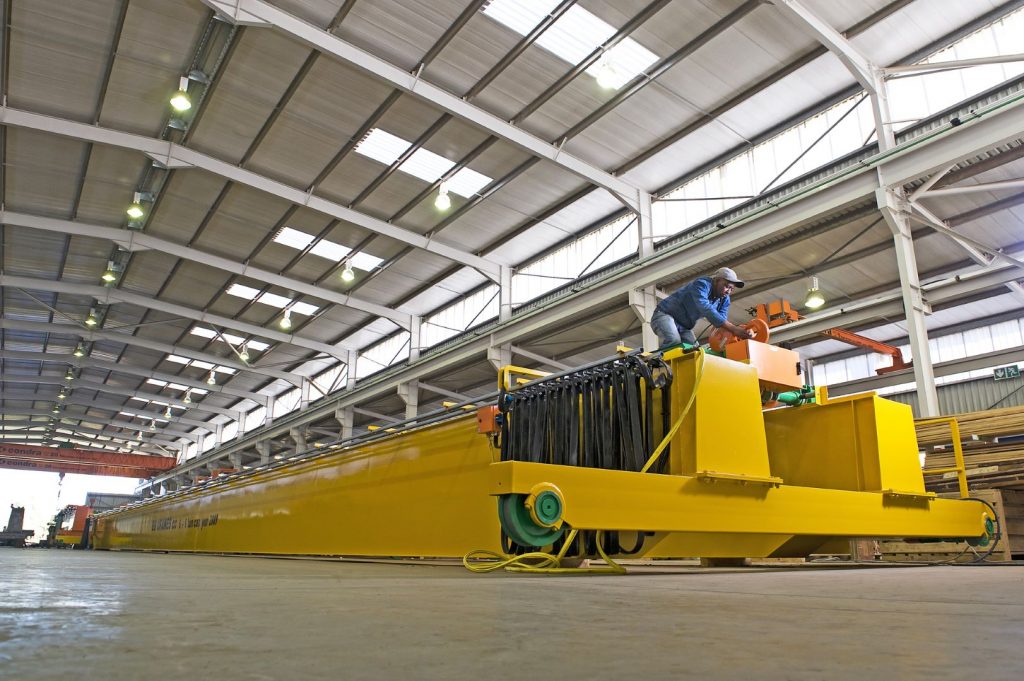CLOSE CO-OPERATION THE KEY DURING NEW PLANT CONSTRUCTION
Paragon Steel Structures’ construction of a rubber processing factory in the KwaZulu-Natal Midlands will soon involve the installation of two overhead cranes to work the floor area of the soon-to-be-completed plant.
Peter Hallowes, Paragon’s managing director, reports that the cranes will be delivered by manufacturer Condra in September, with installation and commissioning scheduled for the same month. The order was placed in April.
Condra’s two cranes are electric overhead travelling machines with a double-girder configuration and individual lifting capacities of 40 tons. They are identical apart from long-travel speeds of 31 and 10 metres per minute, different in order to maximise production efficiencies.
Hallowes said that there is close and ongoing co-operation between Condra and Paragon to ensure that all details of crane design, delivery, installation and commissioning dovetail precisely with his company’s ongoing construction of the end user’s plant.
The cranes will span the full 28 metres of the factory floor, moving raw rubber from the receiving area to the processing area, then transferring processed material to different points within the plant for specific value-adding procedures.
Crane lifting heights are a little over nine metres.
Hallowes said that his company’s contract for the new factory fitted well with Paragon’s corporate vision, which is to reliably and as far as possible lighten the workload of heavy industrial environments.
“Paragon Steel Structures is in the business of manufacturing and processing structural steel and platework,” he said. “We move tons, and we rely on Condra to carry this philosophy through to the lifting equipment needed for loading, offloading and fabrication processes. Cooperation has to be – and is – tightly coordinated.”
Condra and Paragon Steel Structures have worked together on new factory projects before, at Pietermaritzburg in South Africa, and at Luanshya in Zambia.
For the Midlands project in KwaZulu-Natal, Condra is bringing to bear its previous experience with cranes for conveyor belting and rubberised injection moulding plants.
When complete, the two new 40-tonners will feature frequency drives on the hoists and cross-travels for accurate and easy load positioning, and walkways across the full length of their 28-metre spans.

A spokesperson for Condra said that the cranes would be hard-working machines that will need to perform durably and reliably. Though they are being built as Class FEM-2M machines, manufacture is being undertaken very close to 3M standard because of the minimal periods during which these cranes are expected to stand idle, the spokesman said.
Hallowes said that Paragon awarded the lifting equipment contract to Condra because of the company’s reputation for close co-operation and liaison during complex factory construction.
“Our experience with them is that their involvement tends to go a lot further than simply supplying a crane to specification,” he said.
After delivery of the completed machines to site, installation and commissioning will be undertaken by Durban-based specialists Natal Cranes & Hoists.
Peter Hallowes, Paragon’s managing director, reports that the cranes will be delivered by manufacturer Condra in September, with installation and commissioning scheduled for the same month. The order was placed in April.
Condra’s two cranes are electric overhead travelling machines with a double-girder configuration and individual lifting capacities of 40 tons. They are identical apart from long-travel speeds of 31 and 10 metres per minute, different in order to maximise production efficiencies.
Hallowes said that there is close and ongoing co-operation between Condra and Paragon to ensure that all details of crane design, delivery, installation and commissioning dovetail precisely with his company’s ongoing construction of the end user’s plant.
The cranes will span the full 28 metres of the factory floor, moving raw rubber from the receiving area to the processing area, then transferring processed material to different points within the plant for specific value-adding procedures.
Crane lifting heights are a little over nine metres.
Hallowes said that his company’s contract for the new factory fitted well with Paragon’s corporate vision, which is to reliably and as far as possible lighten the workload of heavy industrial environments.
“Paragon Steel Structures is in the business of manufacturing and processing structural steel and platework,” he said. “We move tons, and we rely on Condra to carry this philosophy through to the lifting equipment needed for loading, offloading and fabrication processes. Cooperation has to be – and is – tightly coordinated.”
Condra and Paragon Steel Structures have worked together on new factory projects before, at Pietermaritzburg in South Africa, and at Luanshya in Zambia.
For the Midlands project in KwaZulu-Natal, Condra is bringing to bear its previous experience with cranes for conveyor belting and rubberised injection moulding plants.
When complete, the two new 40-tonners will feature frequency drives on the hoists and cross-travels for accurate and easy load positioning, and walkways across the full length of their 28-metre spans.

Very wide-span double girder overhead crane nearing completion in Condra’s Johannesburg factory. The two 40-ton cranes for Paragon Steel Structures, which will each have a span of 28 metres, are similar to the crane in this photograph.
A spokesperson for Condra said that the cranes would be hard-working machines that will need to perform durably and reliably. Though they are being built as Class FEM-2M machines, manufacture is being undertaken very close to 3M standard because of the minimal periods during which these cranes are expected to stand idle, the spokesman said.
Hallowes said that Paragon awarded the lifting equipment contract to Condra because of the company’s reputation for close co-operation and liaison during complex factory construction.
“Our experience with them is that their involvement tends to go a lot further than simply supplying a crane to specification,” he said.
After delivery of the completed machines to site, installation and commissioning will be undertaken by Durban-based specialists Natal Cranes & Hoists.


